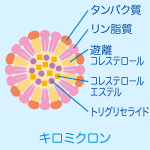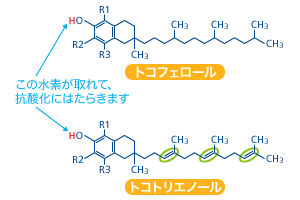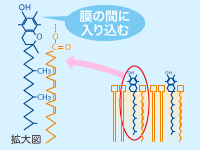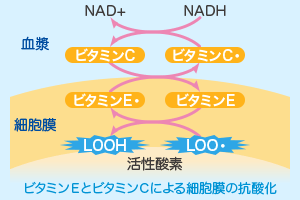VitaminE
Vitamin E was originally in the 1920s and 1930s
Discovered by infertile mouse experiments
It is a fat-soluble vitamin.
Also known as “tocopherol"
tocos (giving birth), phero (empowering),
It comes from the meaning of ol (a general term for compounds with hydroxyl groups).
But after that, vitamin E has
The powerful rust removing effect (antioxidant effect) of the body has come to the fore.
It is now called rejuvenating vitamins.
Vitamin E absorption

After eating Vitamin E, put it in a protein ball (chylomicrons)
It will be absorbed and carried.
At this time, if there is a lack of protein,
Vitamin E that I took so much without making this ball
There is a risk that it will be wasted.
Also, since vitamin E dissolves in oil,
The absorption rate depends on the amount of fat you eat together.
When you take vitamin E, be sure to take oil and protein.
Types of Vitamin E
Vitamin E is roughly divided into two types: tocopherol and tocotrienols.
α-tocopherol α-tocotrienol
β-tocopherol β-tocotrienol
γ-tocopherol γ-tocotrienol
δ-tocopherol δ-tocotrienol
Tocopherol
Only α-tocopherol was found as an anti-fertility factor.
From the perspective of pregnancy
Beta, γ, and δ-tocopherol have very low levels of activity.
However, the most noticeable antioxidant effect at present is
δ is the strongest, in the order of δ> γ> β> α.
Differences between tocopherols and tocotrienols

Whether or not the bonds between carbons are doubled
The difference between tocopherols and tocotrienols.
The double tocotrienols are better
Because it is flexible, it penetrates the cell membrane well and
It works quickly.
Tocopherol: lasting action
Tocotrienols: fast-acting action
Differences between natural and synthetic vitamin E d-α-tocopherol and dl-α-tocopherol
In dietary supplements,
Natural Vitamin E d-α-tocopherol,
Synthetic vitamin E is labeled as dl-α-tocopherol.
Synthetic Vitamin E stabilizes,
In places where antioxidants work (hydroxyl group, ○ part in the figure below)
It has a substance to stabilize it.
Therefore, synthetic vitamin E cannot be expected to have antioxidant capacity.

Effect of Vitamin E
α-tocopherol
Antioxidant, anti-inflammatory,
Oxidative stress suppression effect, etc.
γ-tocopherol
Natriuretic effect
δ-tocopherol antioxidant activity Tocotrienol antioxidant activity,
Natriuretic effect, anti-allergic effect, antitumor effect, anti-arteriosclerosis effect, etc.
Vitamin E is expected to be effective when taken together, not alone.
How Vitamin E Works

Vitamin E dissolves in lipids, so
Invades the lipid (unsaturated fatty acid) part of the cell membrane
It is thought to protect cell membranes.
Because there are 60 trillion cells in our body,
If you try to protect it all, you will need a lot of vitamin E.
Vitamin E function and deficiency symptoms
Antioxidant of fat
Symptoms that are likely to occur when there is a shortage
Easy to form lipid peroxide
(The cause of aging, age spots, arteriosclerosis, and lifestyle-related diseases)
Biological function regulation
Symptoms that are likely to occur when there is a shortage
Menopause / Menopause Decline in reproductive function Autonomic imbalance
Blood circulation promotion
Symptoms that are likely to occur when there is a shortage
Stiff shoulders, headache, menstrual pain, arthralgia, low back pain, cold cardiovascular disease
Synergistic effect of Vitamin E and Vitamin C

Vitamin E can be obtained by taking Vitamin C together.
A synergistic effect can be obtained.
Vitamin E protects the oily parts of the body from active oxygen.
At this time, if vitamin C is also present,
Vitamin E that got tired after removing rust
It will bring you back to life again.
Appropriate amount of Vitamin E
We recommend taking a more appropriate amount of vitamin E for the following people:
athlete
Those who get a lot of sunlight
smoker
Those who are in an environment with a lot of pollutants
Those with a lot of stress
Those who often eat commercially available fried foods
Those who consume a lot of unsaturated fatty acids
Those who want to improve their condition
Foods high in Vitamin E
The amount of vitamin E required per meal is 2.2 mg.
The following vegetables are high in vitamin E.
Shiso
basil
Turnip leaves
broccoli
Vitamin E check
Check the following items.
If so, you may be deficient in vitamin E.
・ Stains have appeared
・ Irregular menstruation
・ I feel my age recently
・ I’m worried about menstrual pain
・ Living an irregular life
・ I’m worried about infertility
・ Eating habits are disturbed
・ I’m worried about menopause
・ I’m tired
・ Somehow lazy
・ I can’t control my body temperature well
・ Many stiff shoulders and headaches
・ Low-grade fever continues
・ Gastrointestinal upset
・ Cold sensitivity
・ Arrhythmia appears

ディスカッション
コメント一覧
まだ、コメントがありません